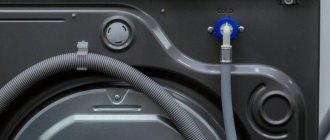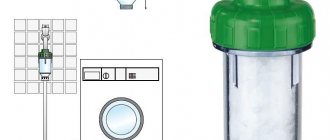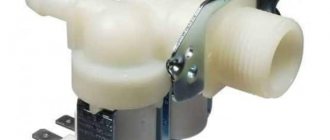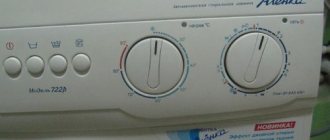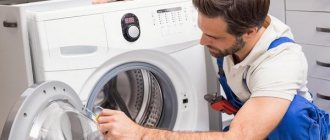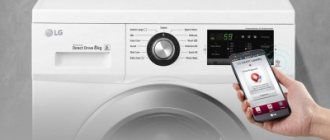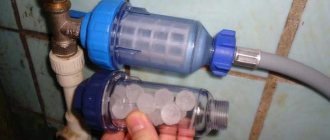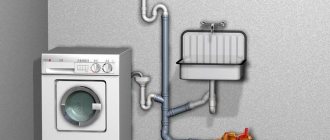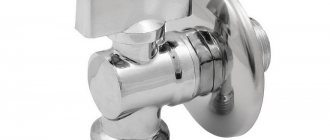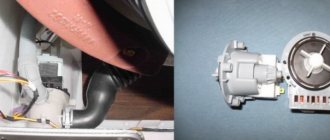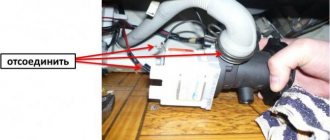An unpleasant situation when wastewater from the sewer enters the washing machine tank. A “swampy” smell and dirty laundry are guaranteed. This can happen due to improper connection of the machine to the drain. But what to do if the realities of life are completely incompatible with the installation instructions? In this case, a non-return valve for the washing machine will help. This special device allows used liquid to flow in only one direction. Useful information about this detail within the article.
Non-return valve for washing machine drain
Currently, a washing machine is an integral attribute in every apartment. Any housewife is interested in keeping her linens crystal clean. The quality of washing depends not only on the characteristics of the machine and powder, but also on the correct connection. The washing machine must not only pump clean water, but also ensure that waste water is discharged into the sewer system. As a rule, there are no problems with water injection. And illiterate organization of drainage can lead to a number of problems. Dirty water from sewer pipes can flow back into your car. To block the reverse flow of water, it is necessary to install a check valve on the drain hose of the washing machine, which is also called an anti-siphon.
Why do you need an antisiphon?
High-quality washing is impossible without an anti-siphon. Its main function is to pass dirty water into the sewer and prevent it from entering back. An anti-siphon is a small pipeline element with a tip for connecting to a hose and a built-in check valve. The diameters of the inlet and outlet pipes are different. Most often, this device is sold complete with a washing machine.
Anti-siphon valve
Without it, high-quality washing is only possible if certain operating conditions are met. The main condition is that the drain hose must be higher than the sewer pipes. Many people organize a drain right next to the floor in order to preserve the interior. This erroneous decision leads to an increase in the siphon effect. But even with a properly connected machine, problems can arise. If the sewer pipes have not been changed for a long time, a “siphon effect” also occurs when draining.
This is quite easy to determine. The operating time increases significantly, the quality of washing decreases, and energy costs increase. These are manifestations of the “siphon effect”. It appears if the drainage is not organized correctly. The diameter of the machine drain hose is much smaller than the diameter of the sewer pipe. Draining leads to a release of pressure, water is pumped out of the drum. The machine is forced to draw water from the water pipe and heat it. As a result, the operating time of the unit increases and water consumption increases. These problems can be avoided by installing a siphon with a check valve.
Operating principle of a check valve
A siphon with a check valve is mounted on the drain pipeline in an arbitrary location. When the drain program is turned on, the pump starts to pump out water. The pressure in the hose increases and water flows freely through the valve. After the drain cycle completes, the water stops flowing and the pressure drops. In this case, the device closes, blocking the passage. A tight connection is formed. In this way, the passage for water to enter the drum from the pipe is blocked. Due to the height difference between the inlet and outlet pipes, the reaction time to pressure changes is minimal.
This is interesting: Pump to increase water pressure in the house: calculators for calculating the required pressure
The most commonly used locking device is:
- polypropylene ball;
- spring.
The principle of operation of the antisiphon
The locking mechanism is a small ball of air. When direct fluid pressure is removed, the ball rests against the sealing membrane. When back pressure occurs, the force of pressing the ball against the membrane only increases. Reverse penetration of liquid is not possible.
No ball cleaning required. Special ribs in the valve body serve for self-cleaning of the ball. A siphon with a spring valve uses a spring as the closing mechanism.
The design of the mechanism makes it possible to install it on any section of the pipeline. The installation location does not affect the quality of work.
All valve modifications are made of high-quality durable plastic. Therefore, the devices have a long service life. The service life can only be affected by water quality. Too hard water in the water supply system destroys the elements of the device.
Types of check valves
There are several types of antisiphons for washing machines:
- collapsible (segmental);
- non-separable;
- wall;
- mortise;
- washing
Types of antisiphons
Double check valve
Wall check valve
It is better to choose collapsible devices for houses with hard water. If it gets dirty, it can be dismantled and disassembled. Without cleaning, the device can quickly fail. In addition, only such valves are suitable for certain brands of washing machines (for example, from the manufacturer LG). This is usually stated in the instructions for the washing machine. If the water is of good quality, a non-separable option is quite suitable. It is much cheaper than segment ones.
Non-separable valves are subject to forced replacement. Devices need to be checked and replaced more often with hard water.
Mortise devices are convenient to use when connecting a direct drain into a sewer pipe. To install the valve, a special mortise hole is prepared in the pipe. This connection option is somewhat more complicated.
Wall-mounted ones have the most aesthetic appearance. But they are significantly more expensive than others. It is mounted between the washing machine and the wall. This is the most compact device.
Wall check valve
The washer is not suitable for washing machines. Their purpose is a sink siphon. There are also many models with decorative inserts. Inserts are usually made of high quality stainless steel. But such models are several times more expensive. But it should be remembered that appearance does not affect quality.
There are no special rules when choosing an antisiphon. The main thing is that the device fits the washing machine and the drainage structure. Therefore, first of all, you need to carefully study the machine’s instructions and the design features of the sewer pipes.
DIY installation
Installing the device is not particularly difficult. The installation principle for all varieties is approximately the same:
- connect the siphon to the valve tube (for mortise ones - install it in a pre-prepared cutout in the pipe);
- connect the second output to the drain hose of the washing machine;
- seal all joints with sealant.
Antisiphon tubes have different diameters. Therefore, incorrect connection is completely excluded. The most important thing is to ensure the tightness of all connections.
It must be remembered that in drain mode there is strong vibration of the hose. High-quality connections will help avoid leaks. Before starting, it is necessary to check the operation of the sewer system. If water flow is poor, the pipes need to be cleaned.
This is interesting: Siphons for bathroom sinks
Which manufacturers are better
Check valves for washing machines can be purchased at any hardware store. The variety of manufacturers and price range is quite wide. To ensure that the device works for a long time, when purchasing, it is better to give preference to trusted suppliers. The table shows the most common devices from well-known brands.
| Manufacturer | Type | Characteristics |
| Alcaplast, Czech Republic | APS2 | Plastic, ? 32 mm, for any hoses, one-piece |
| Siroflex, Italy | 012677 | Mortise, spring. |
| Merloni, Italy | 95101800 | Mortise, plastic |
| McALPINE, Scotland | WMV-32WH | Plastic, ? 19-25×32, one-piece |
| ANI Plast | P-12/M500/APS2 | Minisiphon (wall-mounted) |
Whether or not to install a siphon with a check valve is up to everyone to decide for themselves. But you should remember that without it it is impossible to organize a drain. The quality of washing decreases, washing time, water and electricity consumption increases. An inexpensive device that is easy to install even without the involvement of specialists will help avoid these problems.
ALL about ESP: what is it in a car, why do you need the ESP vehicle stability system?
ESP - what is it in a car? This is a very popular abbreviation that many car enthusiasts know. It stands for dynamic electronic vehicle stability control system. In English it sounds like this - Electronic Stability Program, and in German - Elektronisches Stabilitätsprogramm.
In simple words, this is to prevent the car from skidding or sliding sideways on a vertical axis in emergency situations. And this is very important for the safety of the driver and passengers, since few people have extreme driving skills. Here, the system helps the driver cope with dangerous situations in which one can get into an accident, for example, at high speed or on bad roads. Also, some car owners call this system anti-skid.
The ESP system may be called by other abbreviations, depending on the manufacturer, such as ESC, CST, DSTC, PSM or RSC. The essence of the operation of the exchange rate stability system is based on the fact that the system receives signals from different sensors. If the values approach dangerous values, the ESP is automatically turned on.
To understand how ESP works, you need to find out what it is, its operating principle, and familiarize yourself with real examples. I will tell you all this in detail in this article. I promise it will be interesting!
What it is?
Let's go back to history. The prototype of ESP was first invented in 1959 by Daimler-Benz. It was called very modestly - “control device”. Since then, testing of this system began. The system was first installed on the premium Mercedes-Benz CL 600 in 1995. The tests were successful and ESP began to be serially installed on other classes of Mercedes.
Mercedes-Benz CL 600 (1995)
Interesting! The ESP system became popular thanks to one incident. The fact is that in 1997 the new Mercedes A-Class had many disadvantages due to an unfinished center of gravity. Because of this, the car leaned heavily when turning, and during sharp maneuvers there was a high probability of the vehicle overturning. Engineers completely redesigned the Mercedes suspension and additionally introduced the latest ESP system. After this, the system became very popular all over the world.
ESP is an anti-skid system that includes measures to reduce the vehicle's displacement from its current trajectory. This is important for the lateral dynamics of the car (its stability). That is, ESP only reduces the likelihood of the car moving off the road. We must always remember that even a very expensive system will not be able to overcome the laws of physics.
The anti-skid system is a logical continuation of such car systems as ABS and ASR. ABS is an anti-lock braking system that reduces the braking distance. ASR is a traction control system that helps ensure stable and fast acceleration. ESP maintains the vehicle’s trajectory during sharp turns and maneuvers, which is very important when driving on wet or slippery road surfaces.
ESP regulates the lack or excess of “steering” of the car, which actively prevents the occurrence of skidding.
Currently, the ESP system can be installed on all modern cars. In the basic configuration, the stability control system is installed in the basic configuration only on premium cars.
The term ESP is the most famous, but I note that this abbreviation sounds differently for different car manufacturers. I will give examples.
- ESC – Hyundai, ŠKODA, Chevrolet and Lada.
- DSC - Land Rover, BMW, Jaguar and Mazda.
- DSTC - Volvo.
- ESP – Dodge, Audi, Bugatti, Lamborghini, Volkswagen, Nissan, Renault, Peugeot, Mercedes Benz, Kia, Hyundai, Chery, SEAT, etc.
- ASC - BMW and Mitsubishi.
- CST - Ferrari.
- MSP - Maserati.
- IVD - Ford.
- PSM - Porsche.
- StabiliTrak – Hummer, Pontiac, Cadillac, GMC Truck, etc.
- VDC – Infiniti, Subaru, Nissan, Alfa Romeo.
- VDIM - Lexus and Toyota.
- VSA - Honda, Hyundai and Acura.
What does this system consist of and how does it work? The answer is below in the article.
ESP device
In order for ESP to function properly in a car, the following parts are installed:
- Sensors on the wheels that read their rotation speed.
- A sensor that monitors the position of the steering wheel.
- A sensor that “sees” how the car moves around its axis.
- Hydraulic mechanism. The control unit controls the pressure in the brake system on all discs.
- G-sensor (accelerometer). Measures the position of the car in space.
- The ECU is an electronic control unit that constantly reads information from sensors to know when to activate ESP.
Interesting! In expensive cars, the anti-skid system is directly connected to the cruise control, which maintains the set speed on the highway.
Read more:
This leads to the conclusion that budget cars, as a rule, do not have as many built-in systems, so ESP is installed in the basic configuration only on cars in the high price category.
Learn more about how ESP works (required reading).
Principle of operation
The ESP system is an active vehicle safety system that automatically turns on when there is a possibility of skidding or loss of control. The system computer receives data from several sensors (lateral acceleration, wheel rotation, steering wheel position, gas and brake pedal positions, brake system condition and angular speed).
The operation of the ESP is based on activating braking and reducing engine torque in order to prevent the car from skidding.
What commands can be issued in a given situation on the road:
- Braking one or all wheels. This will help prevent skidding or help increase the turning radius at high speeds. Also, ESP in a certain situation can reduce the braking force, even if the frightened blonde presses all the pedals with all her might.
- Connection to the engine control unit in order to turn off its cylinders in order to reduce its speed (torque), up to completely turning off the gas pedal.
- Adjusting the rotation of the front wheels.
- In cars with adaptive suspension, it affects the level of its damping (the degree of shock absorption of the springs).
- Adjusting the automatic transmission to change gears.
- If a driving problem occurs as a result of operating cruise control, it will act together with ESP and other systems to smooth out the vehicle's movement.
Despite the fact that this is a very advanced safety system, it cannot see the actual width of the roadway, nor can it accurately calculate the trajectory of the car that will be the safest. It follows that the driver himself must direct the car in the desired direction, and ESP will provide stability and controllability.
The anti-skid system can operate at any speed and vehicle operating mode (coasting, braking, acceleration).
When cornering, ESP monitors the trajectory of movement, which should be the position of the steering wheel. If deviations appear, the stabilization system will reduce engine speed and slow down in order to quickly return the vehicle to its previous trajectory. ESP is especially useful on icy or wet roads.
Video: ESP. What it can do and how it works
For example, at a very high speed when turning a car began to skid. If the driver starts to brake, the car may spin out. If he does not press the brake, there is a chance of flying off the road into a ditch. The active anti-skid system will instantly determine which wheels need to be slowed down or by how much the fuel supply needs to be reduced in order to straighten the trajectory. Agree, this is a mega-useful thing in critical situations. You just turn the steering wheel, and the stabilization system itself thinks about how best to fit even into a sharp turn.
What else is useful in the ESP system?
- Differential locking function, which allows you to transfer torque to exactly that wheel in order to level the car. The differential must have electronic filling. This is a device that transmits different torques to each consumer.
- Help the driver keep the steering wheel in the desired position. This is especially useful in a rut.
- Rear wheel steering. The main thing is that this function is already installed on the car.
Let's look at the operation of ESP using real examples.
Why is ESP needed in a car?
Let's give a real example of how the anti-skid system works.
For example, you are calmly driving straight along a flat road. And suddenly a large animal or a drunken person runs out onto the road ahead. What will you do?
There isn't much choice here - slam on the brakes and turn the steering wheel sharply in the hope of avoiding an obstacle. If the speed is low, the road grip is acceptable and there are no other cars nearby, then the maneuver will be successful. And in the worst case scenario, the car will skid. And in winter, even with a normal turn, the car will start to spin on the road.
What options are there if a skid begins?
- If the driver is experienced and knows the techniques of extreme driving, he will be able to handle this situation without any electronics or systems. Here it is appropriate to engage a lower gear, brake intermittently, then sharp gas, leveling, a careful turn, and so on. Perhaps you have this skill. Then everything is OK. If you do not have experience, then there is a possibility of a serious accident.
- Press the brake all the way and turn the steering wheel as much as possible to avoid a collision. If you manage to get around the obstacle, then sharply turn the steering wheel in the opposite direction without releasing the brake pedal. If there is no ESP, then no matter what the drive, the car will go into a long drift or an uncontrolled “dance”. All this can also end very badly.
- If the driver is an inexperienced blonde, but the car has an ESP system. Here it will be very difficult to lose complete control over the controls. The most important thing is that the car simply has time to go around the obstacle, and the system itself will correct the movement of the car. Then an accident can be avoided.
How will the algorithm for the anti-skid system work here in the event of a skid when turning left?
- The accelerometer detects the start of a skid and transmits this to the ESP system.
- At the same moment, information is received from other sensors.
- The ESP instantly calculates the direction and speed of the vehicle's lateral displacement.
- A command is transmitted to reduce the fuel supply and brake the left rear wheel.
- As a result, the car drives slower and straightens out when turning, no matter what the driver does at that moment (even if he presses his feet on all the pedals).
Using ESP is easy. It will be enabled by default. But there are also nuances here. About them below.
How to use ESP in a car?
Remember! ESP is always active and can turn on at any speed and movement of the car.
There is an opinion among car enthusiasts that the anti-skid system can prevent experienced drivers from coping with a skid. For example, sometimes you need to increase speed to get out of a skid, and ESP artificially limits fuel injection. But this is applicable for very experienced drivers. Typically, such skills are not required for those who commute from work to home.
For those who love active driving, the stabilization system has special modes when you can drive to your heart's content, and it will only turn on in critical situations.
In most cases, I do not recommend turning off ESP to prevent even the remote possibility of an accident, especially if the driver is distracted or simply unable to react quickly.
Despite the fact that ESP ensures safe driving and smoothes out many mistakes of an inexperienced driver, you should not rely entirely on the stabilization system. Just don't put yourself in dangerous situations.
Does it make sense to disable ESP?
How and when to turn off ESP
In almost all cars, it is not possible to disable the stability control system. But on some cars this feature can be disabled. But it’s not so simple here - it can be partially turned off, that is, additional systems (ABS, ASR and others) will remain working. Or ESP will turn off for a while, and after reaching a certain speed or after some time, the stabilization system will turn on automatically.
ESP button in a car indicates that the car has a stability control system installed.
When should ESP be disabled?
- If the car has wheels of different diameters.
- When driving on sand, off-road or ice.
- If there are chains and anti-skid bracelets on the wheels.
- In case of rocking the car to get out of heavy mud.
- While installing the spare wheel.
- When diagnosing a car.
In these cases, there will be a false activation of ESP, in which the system will reduce engine speed and interfere with adequate driving.
Remember! If the car is stuck in a deep rut, then you should not turn off ESP. Many cars have a traction control system that only works when the stability control system is on. Other systems, such as ABS and EDS, also depend on ESP.
How to turn off ESP?
- Press the ESP off button.
- In the on-board computer, disable the ESP system.
What to do if the system behaves inappropriately? I will describe the main problems that car owners face.
Reasons for turning on the ESP lamp
The exchange rate stability system has its own ESP indicator on the instrument panel. This indicator lights up from time to time depending on the situation. Why might this happen?
- If the ESP indicator blinks, this means that the system is trying to align the vehicle’s trajectory, or the ASR (traction control) system has been activated.
- If the ESP lamp does not light up on a moving car, this means that the movement is stable and there is no point in interfering with the control of the vehicle.
- If the indicator does not light up when the car is stationary, this means that all electronic systems associated with ESP are operating without errors.
- If the ESP indicator is on all the time, then this indicates an error in the operation of one of the elements (and there may be more than 15 of them). Even simple uneven tire wear or the installation of a new spare tire can affect the constant glow of the indicator. In any case, you need to diagnose the ESP at a service center.
If you do not want to visit service centers, you can check what the problem is with the constant light of the indicator.
- The system itself was turned off. On some cars, ESP will not turn on until it crosses the 50 km/h mark.
- Examine the condition of the wheels and tires.
- Inspect the valve body of the anti-lock braking system.
- Test the car battery voltage. If it is low, the ESP will not work.
Note! The stabilization system may turn on even under strange circumstances, or from time to time. This indicates that the vehicle is running with a continuously running fault scanner.
The system has both advantages and disadvantages. I will talk about this further.
Advantages and disadvantages
Could there be any downsides to this system, which provides excellent driving safety? It turns out yes.
- The stabilization system cannot cope with the recovery from a skid (in front-wheel drive cars) by increasing the torque on the front wheels. This method is often used by experienced drivers.
- On vehicles with all-wheel drive, when there is ice, the best way is to gently apply the gas. And ESP works here on the principle of braking and reducing torque on the wheels, which is less effective.
- On loose surfaces (snow, sand or mud), the stability control system does not work effectively. Better to drive in snow without ESP
- If the car has different tires, the tire pressure is different, or the tread pattern is worn unevenly, then ESP will have problems.
- Some drivers do not like that the system itself controls the accelerator pedal, preventing it from reaching the desired speed. Therefore, if you need to add gas during drifts, ESP will not allow you to do this. Or you will have to temporarily disable the system.
- The car becomes less sensitive to drive because the electronics constantly check all the driver’s actions.
ESP has advantages due to which you can turn a blind eye to its disadvantages.
- The reaction speed of electronics is many times faster than that of a person. In just a few milliseconds, ESP detects the beginning of a skid and measures against it immediately begin to work.
- More comfortable driving when traveling long distances, which eliminates roll when cornering at high speeds.
- Improving car handling and stability.
- Within just 20 milliseconds, ESP “sees” the loss of controllability and activates braking force on the necessary wheels and eliminates the start of a skid before the driver himself realizes it.
- The stabilization system works invisibly, and only the indicator on the instrument panel indicates that ESP has begun its work.
- More advanced systems include features such as rollover mitigation (RSC) and trailer stability control (TSC).
- ESP can be disabled if desired. And some systems have special modes that allow small slips and maneuvers, turning on only in critical situations.
It is important to understand that ESP is not 100% capable of protecting the car from skidding . Always use your head when driving and performing sudden maneuvers. For example, if you want to drive at a speed of more than 120 km/h on an icy road and make a sharp turn, then even the most advanced ESP system will not help.
Some very useful information that car services and car dealerships won’t tell you about.
Secrets and tips
I'll tell you about what's hidden in the ESP system. It turns out that it includes by default such functions as ABS, ASR, EBD and others. You just need to simply check the box in the on-board computer settings using a diagnostic scanner and the additional options will take effect. To do this, you can go to your car’s forum, where they will tell you everything, or contact local craftsmen.
What other free options do you get with ESP?
XDS function . This is a lightweight version of the differential lock. When turning, there will be no feeling of the front of the car drifting.
Tire pressure measurement . This is provided by special sensors. If the air in a tire deflates, its diameter and rotation speed increase. You should see a warning on your dashboard.
Hill start assist . When driving uphill, if you release the brake pedal, ESP will hold the brake until the car moves forward.
Rain sensor tracking . When you activate the wipers, the rain sensor is activated. ESP “sees” all this and begins to increase the pressure in the brakes in order to destroy the water film from the wheels. The driver will not even feel this, and the system is already ready for unexpected situations.
Steering Assist . If the driver is a novice and turns the wrong way when skidding, then ESP, reading data from the steering wheel position sensor, activates the electric power steering from time to time. You will periodically feel heaviness in it when you turn the steering wheel hard, or lightness when everything goes according to plan. The system can also block gear shifts in the automatic transmission to maintain controllability and stability of the machine.
Braking on different road surfaces . Let's say you brake sharply when the right wheels are on the ground and the left wheels are on the asphalt. If the car does not have ESP, then the car will “drive”, but if this function is present, then it will not.
Trailer Stability Assist (TSA) . ESP can “see” the presence of a trailer. When you connect the towbar socket, the stabilization system will understand that you have hitched a trailer and will rearrange its operation algorithms to ensure confident driving. It is very comfortable!
Off-road assistance . Maybe you've watched SUVs get out of such situations when, when off-road, when hanging diagonally, the suspended wheels spin in the air, but then they stop and the car suddenly twitches and moves forward further. This triggers ESP, which distributes traction to those wheels that have better contact with the ground.
Descent assistance . When HDC (Descent Control) is engaged, the driver simply takes his feet off all pedals and relaxes. ESP, together with HDC, will ensure an independent smooth descent of the car even from a steep mountain. All you can do is sit and listen to the brakes crunch.
It is quite possible to enable all of the above features if ESP is installed in the car. The main thing is to find craftsmen who will “modify” your electronics.
Now I will answer the most popular questions about the anti-skid system.
Does it make sense to overpay for ESP when buying a new car?
In Europe, since 2014, all cars produced already have ESP as standard. Here in Russia, this is not yet a mandatory condition.
If you want to have electronic assistants in your arsenal such as skidding assistance, hill climbing assistance, differential locking and others, then you will have to install ESP.
If you buy a new car with ESP, then the main thing is that it has a switch off button. There are also cars with different ESP modes that can be turned on according to your mood (for example, Dynamic - aggressive driving, Natural - normal driving, All Weather - high safety).
Is it possible to install ESP on a car with ABS?
Of course, it sounds very interesting - I bought sensors, installed them on a car with ABS - and you already have an ESP system. Is it really that simple?
Instructions are already freely available on automotive forums. But in terms of money, it’s quite expensive, because you have to buy various parts, and also be able to connect to the electronic control unit and configure it correctly.
However, I believe that you should not modify the car yourself, because there are a lot of pitfalls during installation. The ESP system is a complex thing that should be handled by experienced auto specialists.
Do ESPs differ on cars of different classes?
Yes, both at the hardware and electronics level. For example, some systems have a pair of hydraulic pistons, while others have as many as six.
An ordinary car does not need highly sophisticated systems, but premium cars cannot do without additional options (for example, drying the brakes).
Necessity of application
If the drain hose is connected to the sewer outlet in violation of plumbing standards, then it is likely that dirty water from the sewer pipe will return to the drum of the washing machine. As a result, at the end of the wash you will end up with stale, foul-smelling laundry. The check valve is designed to prevent such a development of events (which, by the way, is called the “siphon effect”).
A non-return valve or anti-siphon should be installed when it is not possible to install the drain hose at the required height. Another case in which this device cannot be avoided is when the washing machine drain is connected through the sink siphon.
You should also think about installing an anti-siphon if you notice signs of a siphon effect during washing. These include: increased washing time, poorly washed items, increased consumption of water and electricity by the washing machine.
Siphon effect
The manifestation of such an unpleasant phenomenon - arbitrary drainage of water into the sewer system or the return of it (liquid) from the sewer into the washing machine tank, is typical for washing machines and dishwashers installed in apartments located on the upper floors of multi-storey buildings. This does not exclude its (“siphon effect”) manifestation in the rooms of the lower levels, if washing equipment is installed incorrectly.
That is, when the outlet end of the tube is below the water level in the tank, as a result of which the water rises and returns to the tank or is spontaneously discharged. The result of this is excessive consumption of electricity and water or laundry spoiled by sewer liquid that needs to be washed again. Avoiding these unpleasant moments is quite simple. You need to buy and install a washing machine water drain check valve. This can be done by calling a plumber or doing it yourself, especially installing a check valve (anti-siphon), the operation is not complicated and does not require special tools.
A check valve for a washing machine on the drain (anti-siphon), mounted on the drain system, in order to prevent waste liquid from returning from the sewer pipes to the tank of the washing machine.
The non-return (anti-siphon) hydraulic valve does not interfere with the planned outflow of dirty water from the tank of the automatic machine. And if there is an attempt to return it from the sewer pipe to the tank, the damper in the valve design immediately blocks its path. In order to purchase and install the necessary drain valve, you need to decide on the types of these devices.
How does it work?
A check valve is a fairly simple device made of stainless metal or plastic. In appearance, it is a bit like a shut-off valve, and its operating principle is similar. An anti-siphon is needed to regulate the flow of water in the pipe, allowing it to move only in one direction.
Initially, the check valve is in a locked state, but when the drain mode is activated, it opens under the pressure of water. When the drain program is turned off, the valve automatically closes, preventing water from returning.
Kinds
There are several types of check valves on the modern plumbing equipment market. They differ in design features, type of installation and scope of application.
Main types of antisiphons:
- collapsible - a metal device consisting of several parts; this type is convenient because, if necessary, it can be disassembled and cleaned;
- non-removable - monolithic structure made of plastic; considered the most budget option;
- mortise - a valve that is installed directly into the pipe, in place of a piece cut out of it;
- washing – check valve intended for use in drain siphons of sinks and washbasins;
- wall-mounted – a beautiful structure made of chromed metal that is mounted on the wall; the most expensive option of all of the above.
This is interesting: Fan pipe: installation and repair
Principle of operation
A washing machine with a drain through a non-return valve, or rather its anti-siphon, works as follows. In a plastic tube of an original shape there is a rubber ball pressed to the drain hole by a spring. The part itself is mounted on a hose for draining waste water, a siphon or a sewer pipe. At the moment when the Samsung automatic washing machine discharges the liquid, it passes through the valve under pressure, pushing the ball aside, and flows into the sewer.
Once the draining is complete, the rubber ball is pressed back into the hole. This leads to the prevention of both spontaneous discharge of water from the automatic machine and the reverse flow of liquid from the sewer.
Do-it-yourself installation of a washing machine drain valve
The general rules for installing a siphon valve of any type of installation and design with your own hands are almost the same.
Due to the fact that an anti-siphon is a device in the form of a complexly curved tube with different connection points, its outlet (end) dimensions of the pipe diameter are also different on both sides.
One of the sides of the valve, optionally, cuts into the sewer system pipe or is connected directly to the siphon, the second is connected to a hose for draining dirty water. The joints are carefully treated with a special silicone sealant. At this point, after checking for leaks, the work can be considered completed.
It should be noted that installation of an anti-siphon is not always necessary. Professionals recommend installing it in two cases. When the washing machine is connected directly to the sewer, and it is not technically possible to install (raise) the sewer system pipe at the level required for proper installation of the machine. That is, the place of the mortise connection is located too low, almost flush with the floor. Or you connect the drain hose to the siphon located under the sink sink.
In any other cases, there is no need to connect a check valve to drain waste liquids from the tank of an automatic washing machine.
How to install a washing machine drain through a non-return valve, see below.
A source of information
Features of use
- Some manufacturers of household appliances add a check valve to the basic configuration of washing machines, but not all do this. Therefore, most likely, you will have to purchase this device yourself in a specialized store.
- If you connect the drain using a check valve, then you do not have to worry about following the recommendations regarding the height of the drain hose. The main thing is to install all elements of the system in such a way that they can be easily accessed in case cleaning or repairs are needed.
- When purchasing a check valve, be prepared for the fact that this device will have to be replaced every few years, as it will be exposed to hard tap water. The better the quality of the product, the longer it will last, but you still shouldn’t overpay - no matter how expensive the device is, sooner or later it will need to be replaced.
Principle of operation
The idea of the device is relatively simple: an anti-siphon valve blocks the drainage coming from the sewer into the drain hose. At the same time, it does not interfere with the drainage of waste water from the washing machine. Most often this is achieved in one of two ways - using a locking ball or a spring. Accordingly, check valves are called ball (ball) or spring.
Imagine a pipe containing a ball. “Good” drains coming through the pipe, that is, from the washing machine, are able to move this ball from its place and pass into the sewer. As soon as the flow of water stops, the ball returns to its place. And in this position, it serves as an excellent barrier to sewer drains: even if they are very close to the drain hose, they will not be able to leak through the ball.
A spring-loaded anti-siphon valve operates in a similar way. Washer drainage can compress the spring and open the valve for proper drainage. When “good” drains do not flow, the spring straightens and the valve closes the lumen of the pipe. Once again, sewage will not be able to penetrate the drain hose.
Installation
Installing a check valve is not a difficult task at all; you can easily handle it yourself, without the help of a master plumber. You can get complete information on installation from the instructions for the device, which you must read, but we will only give brief recommendations.
Antisiphons come in different types, but most are shaped like a tube with two holes. One end of the device must be connected to the sewer (by screwing it into the outlet or cutting it into a pipe), and the other must be connected to the drain hose of the washing machine. To prevent leaks, treat all connections with silicone plumbing sealant.
You can clearly see the valve installation process in the following video.
Layout of the drain system
The operation of installing a drain system involves the use of certain tools and components. You will need:
- a tool for cutting metal-plastic pipes and welding them (when using this type of outlet and connection);
- drain pipe with tips at the ends or corrugation (depending on the type of connection of the machine to the drain);
- siphon, with an outlet for attaching a drain hose and an anti-siphon valve;
- sealing cuffs (possibly Masterprof), ball valve, elastic hose, sealing silicone glue.
Immediately before starting work, it is necessary to check the serviceability of the sewer system. Make sure there are no blockages, leaks or other malfunctions.
Tips for choosing
- Experts say that not all models of drain valves are suitable for your washing machine. The service center will help you choose the appropriate antisiphon. You can also seek advice from an experienced technician who specializes in repairing washing machines.
- The best recommendations are for check valves from European manufacturers. The equipment receives a large number of positive reviews from the Italian companies Siroflex and Merloni, as well as from the Czech company Alcaplast.
Overview of the device and its functions
A non-return valve or anti-siphon is designed to protect the drain system from returning waste water from the sewer back to the washing machine tank. This can and often happens if the machine is not connected to the sewer correctly. In this case, dirty water, along with wastewater, enters the tank, spoils the laundry in the washing machine drum, and also significantly increases energy consumption.
The non-return (anti-siphon) valve does not prevent waste water from leaving the tank of an automatic washing machine from LG, Samsung, Siemens and any other. Moreover, if water flows from the sewer back into the tank, a special damper will immediately block its path. To purchase a high-quality drain with a valve, you need to decide on the types of such devices and their manufacturers. There are five types of anti-siphon valves:
There is no fundamental difference between these devices; they all perform the same function - they ensure normal drainage of water. However, there are nuances when connecting a specific washing machine (for example, LG) to the sewer system. If the quality of tap water leaves much to be desired, a segment valve is installed so that it can be periodically disassembled and cleaned of water stone and debris.
If the water in the water supply is normal, you can install a one-piece anti-siphon valve, but it will still have to be changed every 2-3 years.
Wall valves are quite expensive and are used if drainage communications need to be located in a narrow space between the wall and the back wall of the washing machine. They allow you to significantly save space by placing the device along the wall; in addition, a valve of this design looks very aesthetically pleasing.
Mortise valves are useful if you plan to drain directly into a sewer pipe. In this case, a tap is made into the sewer pipe, and an anti-siphon valve is mounted into this tap. The valve under the sink has a design that is ideal for embedding into a sink siphon, while a similar valve can be installed into a siphon of almost any design.
Washing machine installers recommend several models of check valves. Let's look at them.
- Polypropylene wall-mounted anti-siphon valve from the Czech company Alcaplast. A simple, reliable and relatively inexpensive device that fits the drain hoses of any model of washing machine. Designed for end connection with a sewer pipe. The check valve is spring-loaded, chrome plated, there is a reflector decorating the connection point. Provides perfect drainage of waste water. Approximate price 8 USD
- Polypropylene mortise anti-siphon valve from the Italian company Siroflex. This check valve can be installed by inserting into a sewer pipe or as a connecting element of a drain hose. The mechanism consists of a spring (stainless steel) and a rubber membrane. Provides high-quality water drainage. Approximate price 7 USD
- Polypropylene segmental anti-siphon valve from the Italian company Merloni. This valve is mounted in a siphon under the sink and, if necessary, can be disassembled and cleaned of debris. The valve itself is represented by a spring and a rubber membrane. Provides high-quality water drainage. Approximate price 8.5 USD
Should it be replaced with something else?
A check valve for a washing machine is not such a rare product, but it is not always possible to find it in stores, especially if you live in a small town. Therefore, many are interested in the question: is it possible to use something else to prevent the siphon effect?
Unfortunately, the answer to this question will be negative. There are no analogues to the antisiphon yet. To do without it, you will have to organize the drain in such a way that all elements of the system are positioned as expected, and then there will be no siphon effect.
Sources
https://o-vannoy.ru/stiralnaya-mashina/obratnyj-klapan/ https://vannayasovety.ru/tekhnika/obratnyj-klapan-na-sliv.html
What are the advantages?
If it has already been discovered that the washing machine is connected to the sewer incorrectly, then there are no questions here. A solution to the problem is needed, sometimes very urgently.
But there are other situations when the recommended methods of connecting the drain hose to the sewer are simply not feasible. But I don’t want to use an alternative method - securing the hose to the edge of the bathtub, sink or toilet using a holder. It is in this case that the use of a check valve becomes an ideal option.
Example: the design “drain hose + check valve + sewer pipe” can easily be placed around the bathroom. After this, all that remains is to install a special screen. This solution has one significant drawback. If you have to replace the check valve, access to it may be difficult. It is recommended to avoid this option.
